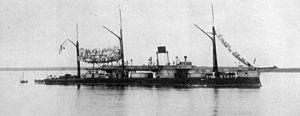 Admiral Greig at anchor; the crew's laundry is drying on her rigging
| |
| Class overview | |
|---|---|
| Builders | Carr and MacPherson, Saint Petersburg |
| Operators | |
| Preceded by | Charodeika class |
| Succeeded by | Admiral Spiridov class |
| Built | 1866–1869 |
| In commission | 1869–1909 |
| Completed | 2 |
| Scrapped | 2 |
| General characteristics (as built) | |
| Type | Monitor |
| Displacement | 3,820–3,881 long tons (3,881–3,943 t) |
| Length | 262 ft (79.9 m) (o/a) |
| Beam | 43 ft (13.1 m) |
| Draft | 21 ft (6.4 m) |
| Installed power |
|
| Propulsion |
|
| Speed | 10 knots (19 km/h; 12 mph) |
| Range | 1,200–1,500 nmi (2,200–2,800 km; 1,400–1,700 mi) at 9 knots (17 km/h; 10 mph) |
| Complement | 269–74 officers and crewmen |
| Armament | 3 × twin 9-inch (229 mm) Rifled muzzle-loading guns |
| Armor |
|
The Admiral Lazarev class was a pair of monitors built for the Imperial Russian Navy in the late 1860s, which designated them as armored turret frigates. Four ships were ordered, but the last two were significantly modified during construction and became the separate Admiral Spiridov class. The sister ships were assigned to the Baltic Fleet upon completion and remained there for their entire careers. Aside from one accidental collision, their careers were uneventful. They were reclassified as coast-defense ironclads in 1892 before they became training ships later that decade. The Admiral Lazarevs were stricken from the Navy List in 1907 and 1909; both were sold for scrap in 1912.